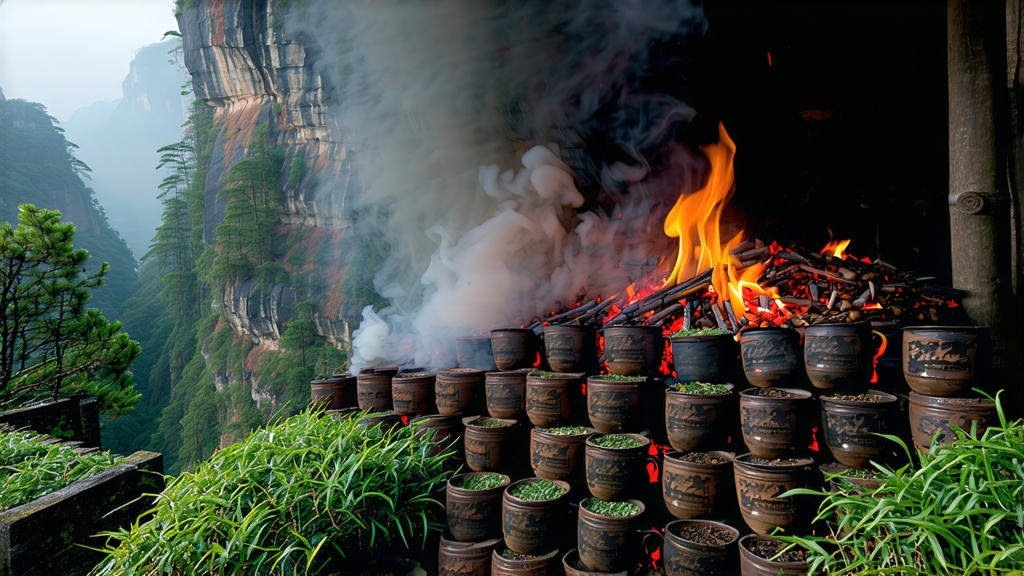
Long before Assam, Ceylon or Earl Grey entered the Western lexicon, the first sip of what Europe would call “black tea” was carried out of the granite gorges of the Wuyi Shan in China’s north-western Fujian. That tea was Lapsang Souchong, a name that still evokes campfire mystery in every language. To understand it is to hold the original template of fully oxidised leaf: the moment Chinese artisans decided to let green become red, and smoke become memory.
History: from borderland tribute to London drawing rooms
The Wuyi range has supplied compressed “dragon-phoenix” tea cakes to Song-dynasty emperors since the eleventh century, but the story of Lapsang Souchong crystallises around 1646, when Qing troops pressed into the mountain prefecture of Chong’an. Villagers in Xingcun, alarmed by the approaching army, rushed to dry freshly picked leaves over open pine fires so that nothing would spoil during evacuation. The improbable result—leaves glossy black, liquor honey-amber, aroma equal to resinous whisky—was presented to passing Dutch traders who, legend claims, bartered it for silver and spread it across the ports of Java and Amsterdam. By 1669 the British East India Company listed “Bohea Souchong” at 21 shillings a pound, more than twice the price of green Singlo, and Samuel Pepys was jotting in his diary about the new “China drink” that smelled of burning logs. In 1840 Queen Victoria reportedly diluted it with milk and sugar in the first public act that would crystallise into English teatime. Thus a wartime accident became the progenitor of every breakfast blend on earth.
Terroir: why Wuyi’s microclimate cannot be photocopied
The core appellation lies within a 60 km radius of the 2 158 m Huanggang summit, inside a UNESCO biosphere reserve where 96 percent of land is forested. Basalt and tuff, shattered by subtropical frosts, form a fast-draining, mineral-rich soil that forces tea roots to probe fissures for micronutrients. A diurnal swing of 15 °C between 35 °C noon humidity and 20 °C mountain nights stalls oxidation enzymes, concentrating malic acid and geraniol. Finally, the canyon mists scatter sunlight into a soft, blue-heavy spectrum that thickens leaf cuticles, giving the finished tea its signature glossy “turtle-shell” sheen. Attempts to transplant the cultivar to Assam, Kenya and even neighbouring counties of Fujian yield flatter cups, proving that Lapsang Souchong is inseparable from the scent of Wuyi pine pollen carried on monsoon air.
Cultivars: two lineages, one name
Western vendors often treat “Lapsang” as a monolith, yet connoisseurs distinguish between smoked and unsmoked styles, each tied to specific cultivars.
- Xingcun Xiaozhong (true “Souchong”): a seed-propagated population of Wuyi Cai Cha bushes, some over 120 years old, whose small, thick leaves tolerate heavy withering and hot firing. Only these leaves are eligible for the traditional pinewood smoke process.
- Wuyi Qizhong (unsmoked “Zheng Shan Xiao Zhong”): selected clonal offspring such as Huang Guan Yin and Jin Mu Dan, baked above charcoal made from local lychee wood instead of pine, yielding a sweeter, orchid-accented cup that satisfies modern Chinese palates and EU pesticide norms. Both share the same plucking standard—one bud, two or three leaves, taken when the third leaf is still half-open, never during morning dew—to ensure balanced polyphenol-to-aroma ratios.
Craft: the four stages that turn leaf into campfire perfume
Traditional production unfolds within 24 hours inside three-storey wooden bungalows called qinglou.
- Withering: baskets of fresh leaf are rotated every twenty minutes over dying embers of Masson pine. The goal is not dehydration but partial enzyme activation; moisture must drop only to 65 % while leaf temperature hovers at 28 °C. Masters read this by touch: the sprig should bend 180 °C without snapping, and the first note of toasted watermelon seeds should rise.
- Rolling: after